Cards In This Set
| Front | Back |
 -17 |
-Geometric Krater from Dipylon Cemetery
-740 BC (8th Century BC) -3 feet tall -Geometric Period -big open mouth signifies krater (mixing water and wine) -Found in dipylon (two gates) cemetery in Athens -ceremonial -grave markers (vase function usually during geometric period) -hole in bottom (somewhat function of a rhyton) (Pour water/wine into vase, pours into ground below for the dead) -registers (organization of Greeks) -narrative frieze -Vase like a body (neck shoulder foot) -Bulk of art on shoulder -meander pattern (secondary to main art focus) -no depth and use of echelon method -represented war, and death and grief of death (not embracing death like Egyptians) -story-telling (epitomizing geometric period) |
 -10 pts |
-Corinthian Black Figure Amphora
-625 BC (7th Century BC) -Amphora vase (storage vessel) -Oriental Period -approximately a foot high -yellowish clay (Corinthian) -Black figure style (Corinthian, adopted by Athenians) +Silhouettes +design is etched out -registers (organization) -rosettes in registers (oriental) -function is aesthetic |
 -11 pts |
-Lady of Auxerre
-650 BC (7th Century BC) -limestone -Oriental Period -goddess or maiden(kore)? -just over two feet tall -Auxerre, France (oldest known location. Now in the Louvre) -Hand over chest indicating prayer may suggest maiden or kore. -Also no headdress suggests maiden -characteristic triangle topped head -Small waist, belted and fondness for pattern are typical during Oriental Period |
 -10 pts |
-Calf Bearer
-560 BC (6th Century BC) -Archaic Period -Smiling (Archaic Smile, of archaic period-first) -dedicated by Rhonbos -symbolizes bringing Athena an offering to thanks for prosperity (prosperous times during Archaic period) -marble -Acropolis, Athens, Greece. -Male perfection (nudity) -Five feet five inches |
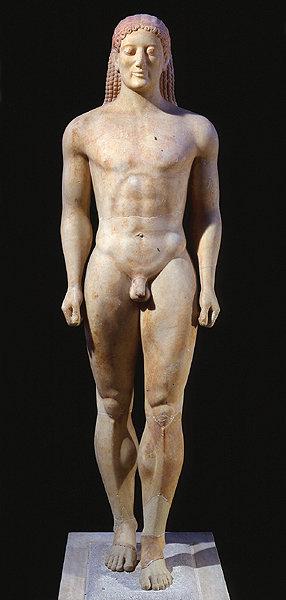 -11 pts |
-Kroisos
-530 BC (6th Century BC) -Archaic Period (600BC-480BC) -Marble -6'4 -grave in Anavysos -kouros statue -much more naturalistic than in other periods +rounded cheeks and hips +natural hair -Was originally painted(eyes, lips etc.), but Greeks normally left the flesh the color of the stone -The man Kroisos died in war. The statue base says that Ares (God of war) destroyed him whilst he was in war -stands in the typical Egyptian stance (one foot forward) |
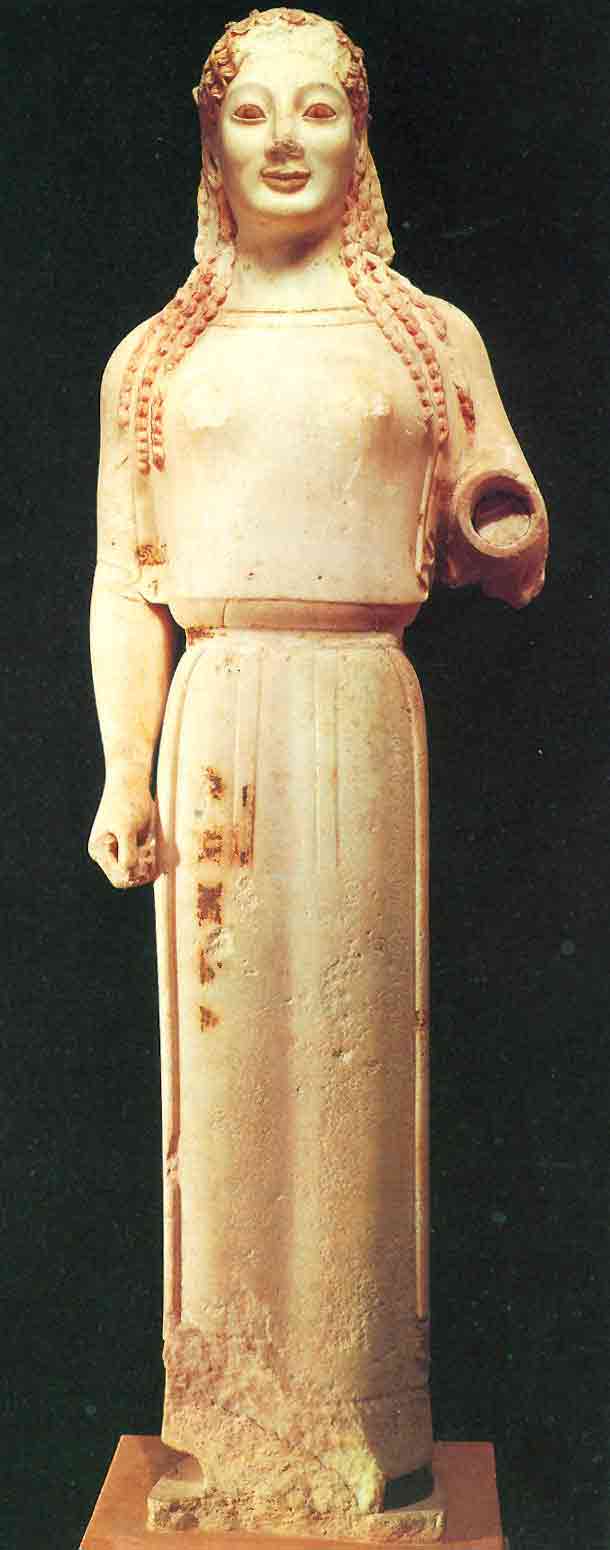 -9 pts |
-Peplos Kore
-530 BC (6th Century BC) -Archaic Period -4' tall -wears a peplos, a belted wool garment meant to make women look like columns -was buried after the left arm was broken off when the Persians came in 480BC -originally was in the Acropolis, but found buried -Originally a votive offering for Athena -Much more naturalistic, especially in comparison to the previous Lady of Auxerre |
 -11 pts |
-Temple of Hera I
-550 BC (6th Century BC) -Paestum, Italy -Archaic Period (archaic temple) -80 X 170 ft -Doric Order -Roof, frieze etc have all disappeared -Hera is the wife and sister of Zeus and the goddess of marriage -called temple of Hera 1 because temple 2 in nearby -even number of columns -has main room (cella or naus) and porch (pronaus) |
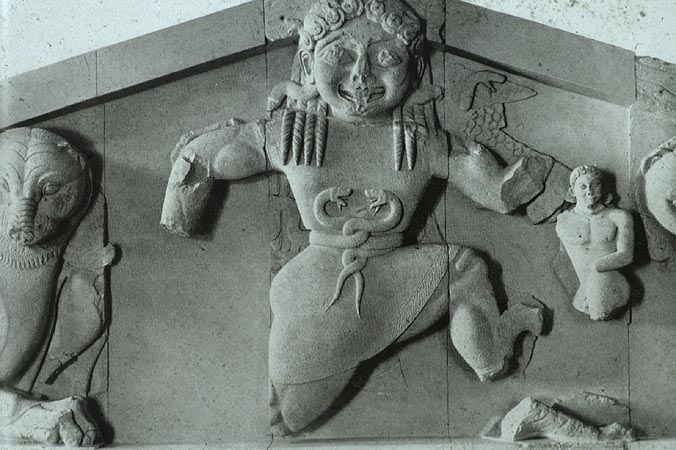 -11 pts -5-13 |
-West Pediment from the Temple of Artemis
-580 BC (6th Century BC) -Archaic Period -Corfu, Greece (where the temple sat) -Doric Order -Pediment had metopes and triglyphs, now destroyed -Artemis is the goddess of the hunt and wild animals, and also associated with the moon -The center figure of the pediment is Medusa (snake haired demon) -Medusa has the typical Archaic bent leg, and arm to show a pinwheel shape symbolizing movement of running or flying -She is surrounded by a human, and Pegasus, the winged horse and then by two guardian felines +The felines are similar to those of Mycenaean lions at the Lions Gate -To the far right is Zeus battling a giant (gigantomachy is popular in Archaic times) |
 -10 pts |
-Gigantomachy
-530 BC (6th Century BC) -Siphnian Treasury, Delphi, Greece -2' 1 -Marble -Ionic Order -The treasury's function was to hold votive statues safely -The north frieze contains an a popular theme of gigantomachy -Features Apollo and Artemis chase a fleeing giant, while a lion attacks another giant -Was originally painted and some metal weapons |
 -13 pts |
-Kleitias and Ergotimos: Francois Vase
-570 BC (6th Century) -Chiusi, Italy -Archaic Period -Black figure (design is etched out) -Krater wide mouth -Red clay indicated Athenian artist (unlike yellow clay of Corinthians) -divided into registers -Kleitias was the painter, Ergotimos was the sculptor +"Kleitias painted me", "Ergotimos made me" (pride of the artist) -more than 200 figures throughout -Many stories, lots based on Homer's writing (The Iliad) +Achilles -Many things were labelled -Featured twisted perspective (profile of face, frontal torsos) |
|
-15 pts |
-Andokides Painter: Bilingual Amphora (black figure) (ALSO SEE RED FIGURE)
-525 BC (6th Century) -Bilingual vase -Amphora (storage vessel) vase - black figure taught to the Andokides painter by Exekias(a famous black figure painter) -recreation of Exekias' original of Achilles and Ajax playing a dice game -foreshortening to show depth -red figure: new development. +Painted instead of etched +More fluid +figures left as color of clay, just painted bg -red figure doesn't show depth, just skill of Andokides painter -Andokides is the potter -Ajax on right, Achilles on left -Bulk of art on shoulder, design adapted to shape of vase - Focus on one narrative -use of spears and design to draw eyes centrally -1"9' |
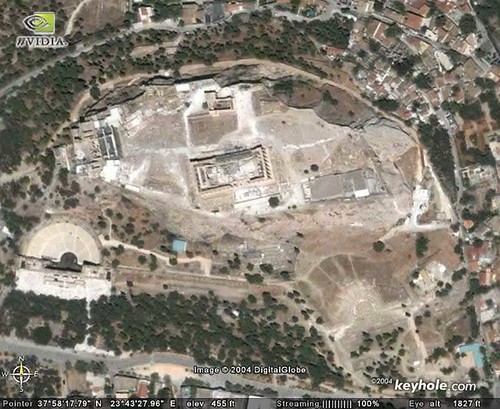 -4pts |
-Aerial View of the Acropolis
-Athens, Greece -Agora is below (site of politics, education, law, military, the mint -path up through Acropolis |
 -13 pts |
-Euphronios, Herakles wrestling Antaios
-510 BC (6th Century BC) -Krater (mixing water and wine) -Euphronios was the painter -red figure -Antaios was a giant (earth giant) -1.5 feet high -Athens reddish clay -two scenes, one on each side to keep from overcrowding -Herakles has upper hand -overlapping of bodies is typical of red figure -bracketing of center scene -foreshortening (body towards legs away) advantage of red-figure |
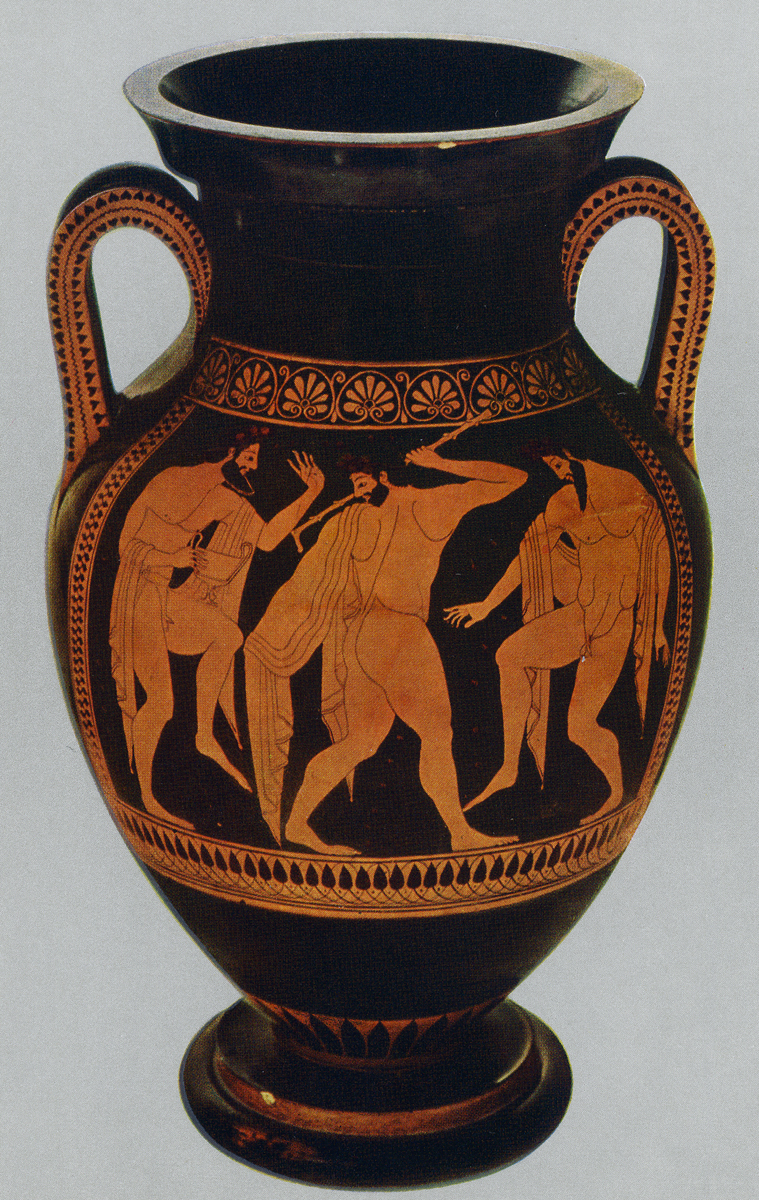 -10 pts |
-Euthymides: Three Revelers
-510 BC (6th Century BC) -Euthymides was rival or Euphronios -Bracketing of main scene -Showing off of foreshortening, all figures three quarter turned -"Euthymides painted me as never Euphronios could do" -2 feet high -Vulci, Italy -Nude males to show beauty of male body -combination of drapery and body to contrast smoothness of skin with texture of drapery +creates movement |
|
-6 pts
-5-23 -Onesimos (Girl preparing to bathe) -No picture...see textbook if necessary. |
-Onesimos (Girl preparing to bathe)
-490 BC (5th Century BC) -interior of a kylix(drinking cup) -Done by Onesimos -Very different to show a woman nude, only in private sphere would this have been allowed -May possibly been a slave woman, so naked not nude. |



